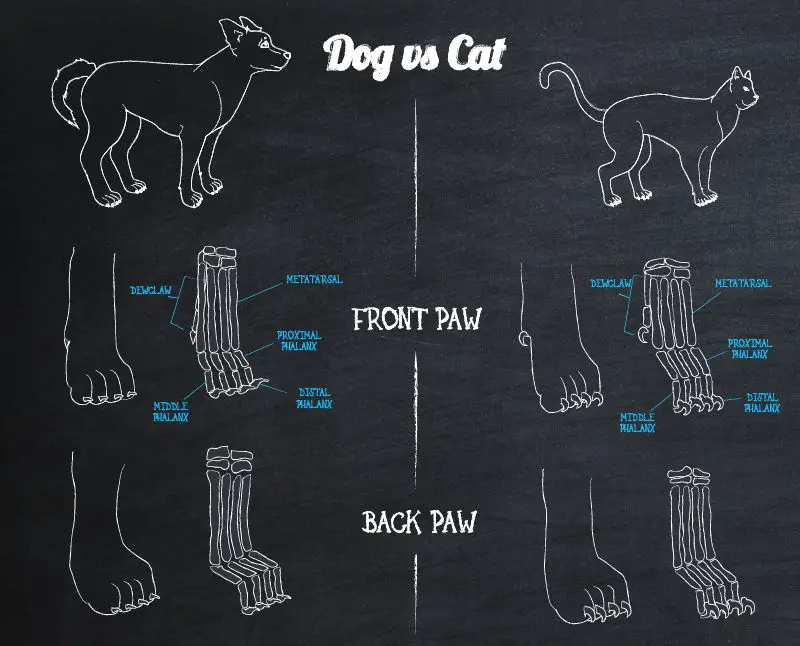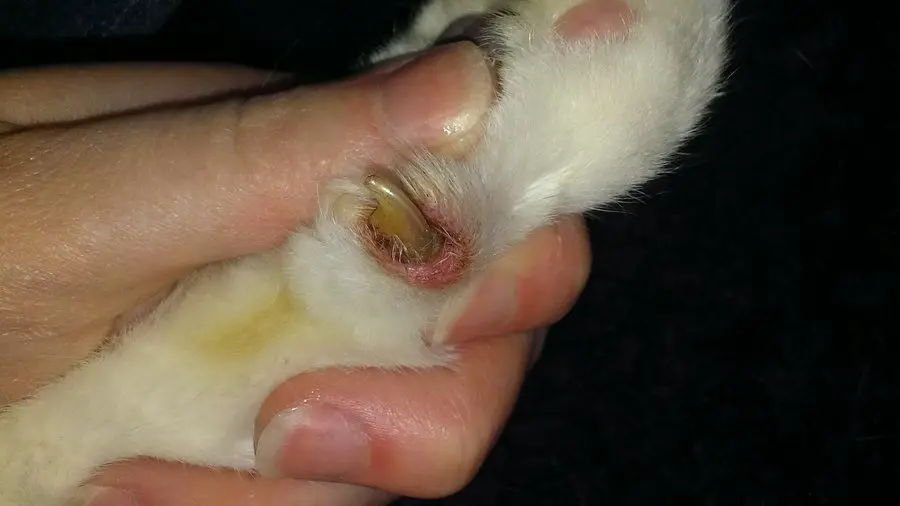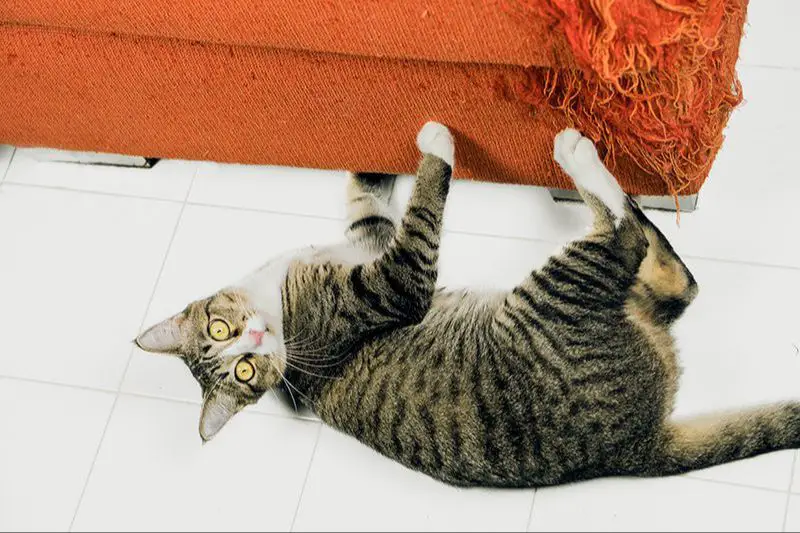Anatomy of Cat Nails
Cat nails are made of keratin, the same protein that makes up hair and horns. Keratin is produced in the nail bed, the area under the nail where new cells are formed to push the nail outward as it grows. The nail bed contains blood vessels, nerves, and connective tissue that nourish the nail.
Cat nails grow from the nail matrix, the area at the base of the nail bed where keratin is produced and pushed forward. As new keratin cells are created, the older ones get pushed toward the tip of the nail and harden into the nail plate. This is what creates the nail’s hardness and strength.
The nail plate is attached to the distal phalanx, the last bone of the cat’s toe. This bone provides support and acts as an anchor for the nail growth. The nail plate slides forward off the end of the bone as the nail grows longer. The nail plate is also held in place by the nail fold, a fold of skin that frames the top and sides of the nail.
Anatomy of Dog Nails
Dog nails, like cat nails, are made of keratin. The keratin is produced in the nail bed, which is part of the dog’s skin. As new keratin is produced, the older keratin hardens into the nail.
Dog nails grow from the nail bed, which is nourished by blood vessels inside the nail. The nail bed contains nerves, so if the nail is damaged or cut too short, it can be painful for the dog.
Each nail is firmly attached to the distal phalanx bone in the dog’s toe. The nail grows continuously from the nail bed and extends beyond the end of the bone to provide traction, help the dog dig, and provide protection for the toe.
Similarities Between Cat and Dog Nails
Despite being different species, cats and dogs share some commonalities when it comes to their nails.
Both cat and dog nails are made of keratin, the same protein that makes up hair and horns. Keratin is very strong yet flexible. It grows continuously, so cat and dog nails need to be trimmed regularly to avoid overgrowth.
The nails of cats and dogs are attached to the distal phalanx, also known as the third phalange or bone, on each toe. This bony core provides strength and structure to support the nail.
Differences
While cat and dog nails share some similarities, there are key differences between them as well. One of the most noticeable differences is that cat claws are much sharper than dog nails. Cat claws are razor sharp, with their key function being climbing and capturing prey. Dogs have blunter nails that are designed more for traction than tearing.

Another difference is that cat claws are retractable, while dog nails are not. Cats can fully retract their front and rear claws inside sheaths of skin when they are not being actively used for hunting, climbing, or self-defense. This helps keeps the claws sharp. Dogs’ nails are always extended and do not benefit from a retractable sheath, though they are sometimes trimmed for health and safety reasons.
So in summary, cat claws are sharper, more curved, and retractable, while dog nails are blunter, smoother, and permanently extended. These differences evolved to suit the natural behaviors and environments of cats versus dogs.
Trimming
Nail trimming is an important part of grooming for both cats and dogs. Cat nails may need trimming every 2-3 weeks, while dog nails typically need trimming every 2-6 weeks. The frequency depends on several factors like breed, lifestyle, and individual growth rate.
Cat nails are sharper and tend to grow faster than dog nails. Indoor cats especially will need more frequent trims since their nails aren’t worn down from walking on various surfaces outside. Outdoor cats may naturally wear down their nails more. For dogs, the growth depends on activity level and ground surfaces. Active dogs on concrete or pavement will wear down nails faster.
It’s best to trim just the sharp tip of the nail, avoiding the quick which contains nerves and blood vessels. Cutting the quick will be painful and cause bleeding. Using nail clippers designed for pets can help avoid this. Trimming should be a regular routine before the nails get too long.
Well-trimmed nails keep your pet comfortable and prevent issues like ingrown nails or scratches to household surfaces or people. Regularly inspect your pet’s nails and trim as needed. For fearful or squirmy pets, work slowly with positive reinforcement to make it a less stressful experience.
Declawing Cats
Declawing cats is a controversial practice that involves surgically removing a cat’s claw down to the first knuckle bone. Many veterinarians and animal welfare advocates strongly oppose declawing, viewing it as an inhumane procedure that can cause physical and psychological harm to cats.
Declawing is an elective procedure and is illegal in many parts of the world, including much of Europe. Some U.S. cities, including Denver, Los Angeles, and San Francisco, have banned the practice unless medically necessary. However, it remains legal in most of North America.
Those against declawing argue that it is equivalent to cutting off part of a human finger and causes unnecessary pain and distress. Possible complications include infection, tissue necrosis, and back pain from altered gait. Declawed cats may exhibit behavioral problems like increased biting or avoiding the litter box.
There are humane alternatives to declawing that allow cats to keep their claws. Regular nail trims and scratching posts can redirect scratching behavior. Plastic caps called nail caps can be applied over claws to prevent damage to furniture. However, declawing remains a personal decision for many cat owners.
Health Issues

The health of cats’ and dogs’ nails is an important consideration for pet owners. Overgrown nails can be problematic in both species. With their sharp claws and tendency to scratch, cats are prone to nail breakage and splitting. This can expose the quick and be quite painful. Dogs’ nails continue growing but may not wear down naturally through activity on hard surfaces. This allows the nails to curl and put pressure on the paw.
Long nails in cats and dogs can:
- Get snagged and torn
- Grow into the paw pads
- Affect joint angles and gait
- Spread bacterial or fungal infections
Cats are especially prone to a nail infection called onychomycosis. This fungal infection turns the nails brittle and distorts their shape. It usually starts in the dew claw. Onychomycosis is contagious between cats and treatment involves antifungal medication and keeping the nails short.
Monitoring nail length and health in both cats and dogs prevents issues. Owners should inspect nails weekly and trim regularly. Seeking veterinary help for any nail abnormalities or infections is advised.
Behavioral Uses
Cats use their claws regularly for essential activities like climbing, hunting, scratching, kneading, and other instinctual behaviors. Their sharp, hooked claws help them grasp surfaces for climbing and enable them to catch prey during hunting. Cats scratch for many reasons as well – to mark territory, remove old layers from their claws, and stretch their body. The act of scratching and kneading are natural behaviors tied to feline instincts.

Dogs use their nails quite differently from cats. While cats rely on their claws for hunting and defense, dogs mainly use their nails for traction and digging. The nails help dogs gain better traction on various surfaces, especially when changing direction during running or play. Dog nails also allow them to dig holes in dirt and sand, which can be an enjoyable natural behavior for breeds like terriers. However, excessive digging can be problematic.
Grooming Tips
Regular nail trims are important for both cats and dogs to maintain health and prevent issues. Trimming your pet’s nails regularly helps keep them at an appropriate length and prevents overgrowth, splitting, and breaking which can be painful. Long nails can also get caught on fabrics and carpets, tear, and bleed.

It’s best to use nail clippers designed specifically for cats and dogs. Human nail clippers are too small and the wrong shape. Cat clippers are smaller and sharper to account for a cat’s tiny nails. Dog clippers are larger and sturdier for thick dog nails. Using the right tools makes trimming easier and reduces the risk of cutting the quick of the nail which contains blood vessels and nerves.
Get your pet accustomed to having their paws handled from a young age. Introduce them slowly to nail clipping by touching their feet frequently and clipping just a nail or two in a session. Reward them with treats afterwards so they associate it with something positive. Be patient, go slow, and make it a regular habit.
With proper tools and techniques, regular nail trims can be an important part of grooming care for both cats and dogs.
Summary
While cat and dog nails share some similarities in anatomy and function, there are also some notable differences. Both types of nails consist of a hard outer layer made of keratin to protect the quick underneath. The nails in both species help with gripping surfaces and can convey information about health and behavior.
However, cat claws are generally more curved, pointed, and retractable, while dog nails are blunter and do not retract. Dogs require more frequent nail trimming as their nails are in constant contact with the ground. Cats are also able to be declawed, which is not recommended for dogs. Proper nail care and grooming is important for both species to maintain health.
In summary, cat and dog nails share fundamental features but have adapted their nail shape and growth patterns to suit their specific needs and lifestyles. While their nail care differs in some respects, regular inspection and trimming helps keep both cats and dogs happy and healthy.